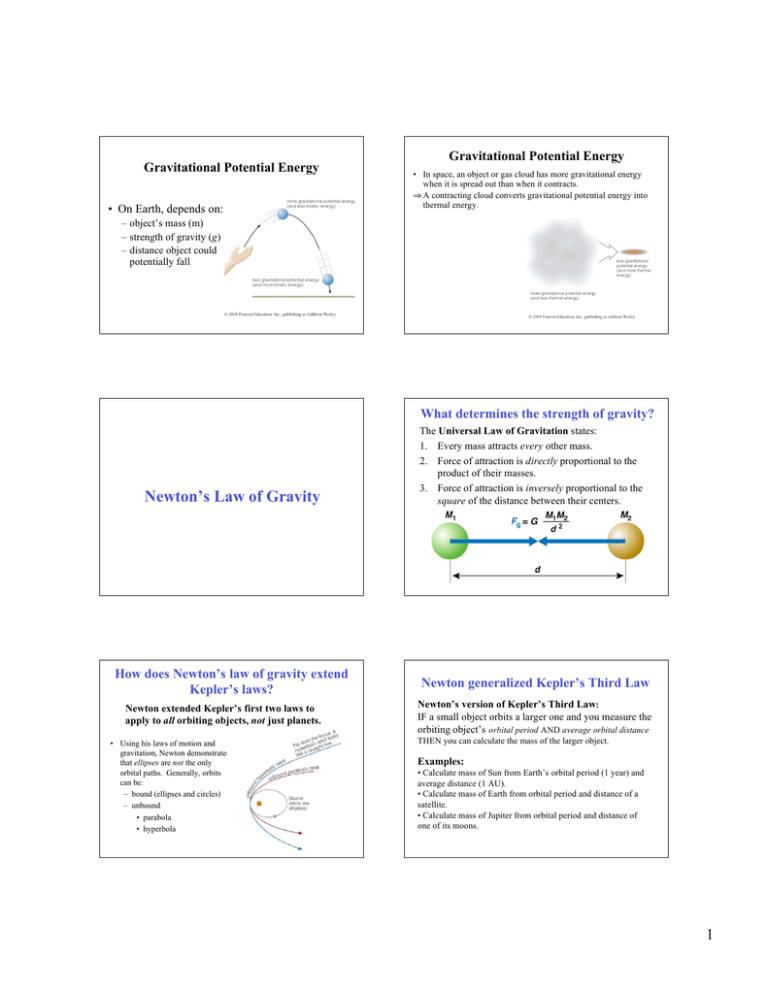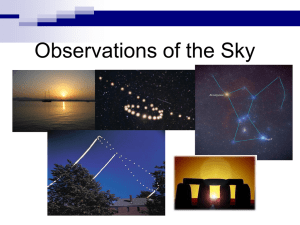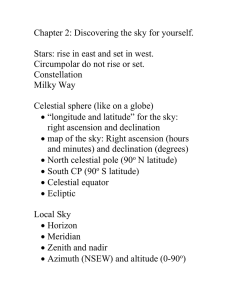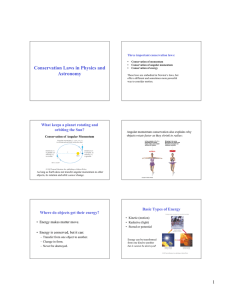Newton`s Law of Gravity
advertisement

Gravitational Potential Energy • On Earth, depends on: Gravitational Potential Energy • In space, an object or gas cloud has more gravitational energy when it is spread out than when it contracts. ⇒ A contracting cloud converts gravitational potential energy into thermal energy. – object’s mass (m) – strength of gravity (g) – distance object could potentially fall What determines the strength of gravity? Newton’s Law of Gravity How does Newton’s law of gravity extend Kepler’s laws? Newton extended Kepler’s first two laws to apply to all orbiting objects, not just planets. • Using his laws of motion and gravitation, Newton demonstrated that ellipses are not the only orbital paths. Generally, orbits can be: – bound (ellipses and circles) – unbound • parabola • hyperbola The Universal Law of Gravitation states: 1. Every mass attracts every other mass. 2. Force of attraction is directly proportional to the product of their masses. 3. Force of attraction is inversely proportional to the square of the distance between their centers. Newton generalized Kepler’s Third Law Newton’s version of Kepler’s Third Law: IF a small object orbits a larger one and you measure the orbiting object’s orbital period AND average orbital distance THEN you can calculate the mass of the larger object. Examples: • Calculate mass of Sun from Earth’s orbital period (1 year) and average distance (1 AU). • Calculate mass of Earth from orbital period and distance of a satellite. • Calculate mass of Jupiter from orbital period and distance of one of its moons. 1 Newton’s version of Kepler’s Third Law p2 = 4" 2 a3 G(M1+M2 ) ! How do gravity and energy together explain orbits? • Orbits cannot change spontaneously. • An object’s orbit can only change if it somehow gains or loses orbital energy = kinetic energy + gravitational potential energy (due to orbit). p = orbital period a = average orbital distance (between centers) (M1 + M2) = sum of object masses • If an object gains enough orbital energy, it may escape (change from a bound to unbound orbit) ⇒ So what can make an object gain or lose orbital energy? • Friction or atmospheric drag. • A gravitational encounter. •escape velocity from Earth ≈ 11 km/s from sea level (about 40,000 km/hr) Escape Velocity Definition: The minimum velocity that a body must attain to escape a gravitational field completely. • • • • A cannonball fired horizontally at 8 km/s from Newton’s mountain would find itself in circular orbit around the Earth (case D). At greater starting speed, but less than 11.2 km/s, it will take an elliptical orbit and return in a slightly longer time (cases E and F). When tossed at a critical speed of 11.2 km/s, the cannonball leaves the Earth and never returns. Tossed at more than 42.5 km/s, it will escape the solar system. Patterns in the Night Sky: The Celestial Sphere We had the sky, up there, all speckled with stars, and we used to lay on our backs and look up at them, and discuss about whether they was made, or only just happened. Mark Twain (1835–1910) Huckleberry Finn 2 What are constellations? The Celestial Sphere A constellation is a region of the sky. 88 constellations fill the entire sky. The Celestial Sphere The Milky Way A band of light making a circle around the celestial sphere. What is it? Our view into the plane of our galaxy. How do we locate objects in the sky? We measure the sky in angles. 1. Know your reference points. 2. Locate an object by its altitude (above horizon) and direction (along horizon) Angle measurements: • Full circle = 360º • 1º = 60′ (arcminutes) • 1′ = 60″ (arcseconds) 3 Why do stars rise and set? Our view from Earth • Stars near the north celestial pole are circumpolar and never set. • We cannot see stars near the south celestial pole. • All other stars (and Sun, Moon, planets) rise in east and set in west. Earth rotates west to east, so stars appear to circle on the sky from east to west. Celestial Equator Your horizon Review: Coordinates on the Earth Why do not we see the same constellations throughout the year? • • • Latitude: position north or south of equator • Longitude: position east or west of prime meridian (runs through Greenwich, England) Depends on whether you stay home: Constellations vary with latitude. Depends on time of year: Constellations vary as the Earth orbits the Sun. The sky varies with latitude but not longitude. altitude of the celestial pole = your latitude 4 The sky varies as Earth orbits the Sun • As the Earth orbits the Sun, the Sun appears to move eastward along the ecliptic. • At midnight, the stars on our meridian are opposite to the Sun in the sky. Summary What are constellations? • A region of the sky; every position on the sky belongs to one of the 88 constellations. How do we locate objects in the sky? • By its altitude above the horizon and its direction along the horizon. Special Topic: How Long is a Day? • Solar day = 24 hours • Sidereal day (Earth’s rotation period) = 23hr, 56min Summary (Cont.) Why do stars rise and set? • Because the Earth rotates around its axis. Why do not we see the same constellations throughout the year? • Because the night sky changes as the Earth orbits the Sun. 5





